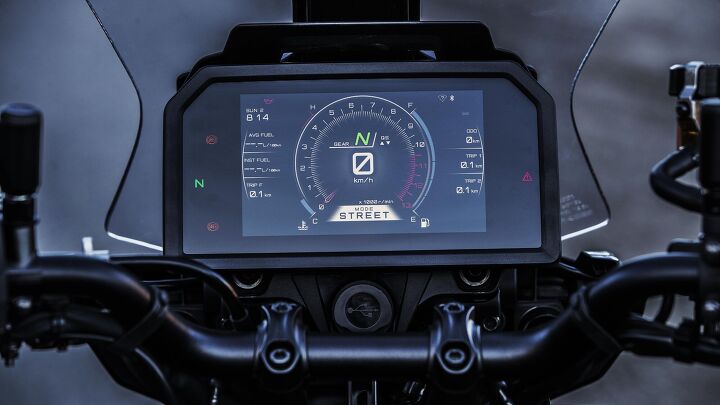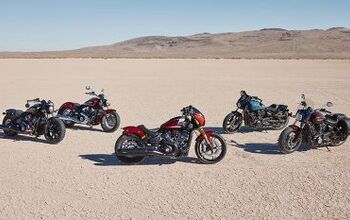Yamaha Tracer 9 GT+ Finally Coming to US for 2024

Sport-tourer equipped with radar-based adaptive cruise control
Last November, Yamaha Motor Europe revealed a new Tracer 9 GT+ at EICMA, a new version of its Triple-powered sport tourer equipped with a 7-inch TFT display, adaptive cruise control, and a radar-linked unified braking system.
Yamaha Motor USA, however, remained quiet about it, and we later learned the Tracer 9 GT+ was not coming to the States for 2023. In fact, even the less techy regular Tracer 9 was left out of Yamaha Motor USA’s returning model announcements.
For those who were considering the GT+, we have good news: Yamaha is preparing to add the Tracer 9 GT+ to its North American lineup for 2024. Confirmation comes to us via the California Air Resources Board which issued an executive order for a motorcycle with the model code “MTT9GPRCGY” for the 2024 model year.
For the uninitiated, Yamaha Motor USA model coding includes the product identifier, a letter for the model year, a “C” for any models meeting California’s emissions standards, and a color code. The 2022 Tracer 9 GT was assigned the model codes “MTT9GTNCR” and “MTT9GTNCS” for certification in California. “MTT9GT” stood for the Tracer 9 GT, the “N” followed the industry standard code for the 2022 model year, “C” obviously stood for California, while the R and S represented the two color options: red and Silver.
For the MTT9GPRCGY, this gives us a MTT9GP model for 2024 (“R”), certified for California (“C”), in the color gray (“GY”). The “MTT9” portion tells us the motorcycle is the Tracer 9, leaving us to surmise the “GP” stands for the GT+. Interestingly, only the Plus version has received an executive order. Yamaha can always add the regular Tracer 9 GT to the certification later, but its absence would suggest that only the GT+ is coming to the U.S. for 2024.
The Tracer 9 GT+ is the first Yamaha model equipped with a millimeter wave radar that enables adaptive cruise control. The system measures the distance between the Tracer 9 GT+ and vehicles immediately in front, and automatically adjusts the cruise control settings to maintain a safe following distance. In Yamaha’s application, ACC allows riders to select one of four different following distances, depicted as a car icon and a sequence of white bars on the Tracer 9 GT+’s 7-inch TFT display.
ACC also has a cornering assist and passing assist for the Tracer 9 GT+. Around corners, ACC adjusts corner speed and acceleration when following behind another vehicle, integrating the engine, brakes and electronic suspension to slow the bike while maintaining stability. When passing, ACC automatically accelerates past the preset cruising speed to pass when the rider activates the turn signal and begins to overtake another vehicle.
The radar system also plays a part in the Tracer 9 GT+’s unified brake system (UBS). Heralded as a first for motorcycles, UBS uses data from both the radar and the 6-axis IMU to assist with braking. The system kicks in when it detects the rider’s braking inputs may not be enough to prevent collision with a vehicle ahead, adjusting braking force for stable deceleration. As its name suggests, UBS also acts as a linked braking system, providing braking with both wheels as needed when only the front or rear brake controls are applied. As with ACC, UBS is linked to the electronic suspension, adjusting damping to maintain stability.
Along with these safety aids, the Tracer 9 GT+ also receives a new quickshifter, new integrated riding modes, a USB-A outlet, and updated rear brakes.
We don’t know how much the 2024 Tracer 9 GT+ will cost yet, though it should be an increase over the Tracer 9 GT’s $14,999 MSRP. We’ll know for certain when Yamaha formally announces the Tracer 9 GT+ for the U.S. market.
Become a Motorcycle.com insider. Get the latest motorcycle news first by subscribing to our newsletter here.

Dennis has been a part of the Motorcycle.com team since 2008, and through his tenure, has developed a firm grasp of industry trends, and a solid sense of what's to come. A bloodhound when it comes to tracking information on new motorcycles, if there's a new model on the horizon, you'll probably hear about it from him first.
More by Dennis Chung






































Comments
Join the conversation
Lots of questions on whether this technology will help or hinder in practice. Until some road use experience is gained we won't know for sure, but in principle since the rider will still be steering the motorcycle the rider should also be aware of what's happening in braking and acceleration, which the rider may not be if a computer is changing those inputs based on sensor and radar readings feeding the ECU's algorithms. I have a specific concern about the passing ACC feature: if the system is set to tell the cruise control to continue acceleration if the turn signal is on, what if the rider forgets and leaves the signal on but isn't planning to pass? Will the system keep on accelerating until the collision avoidance system engages emergency braking?
I'm with Mad4 that I have lots of reservations about a bike that has the capability to override the rider's braking decisions.
I'm not so much concerned about the system working as intended -- no software system is perfect -- it's the failure modes that bother me. Leave the semi-autonomous features for the Tesla boys -- I'd like my motorcycle only responding to my inputs, Thankyouverymuch.